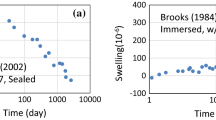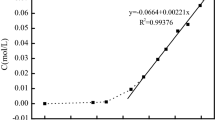Abstract
Abundant studies of cyclic wetting–drying of concrete have suggested a “maximum phenomenon” by which chloride concentrations first increase with depth to a local maximum and then decrease at greater depths. This phenomenon may arise primarily because of carbonation, but may also be exacerbated by cyclic capillary suction and moisture evaporation during wetting–drying cycles. This paper investigates the mechanism responsible for the maximum phenomenon under conditions that exclude cyclic capillary suction. The results show that different chloride maxima form near the surface of all specimens under conditions of either accelerated carbonation or carbonation in normal air environment. A large amount of bound chloride is released when carbonation causes decomposition of Friedel’s salt and C–S–H gel, and the decrease in water content significantly increases the chloride concentration in the pore solution near the specimen surface. The resulting chloride concentration gradient drives free chloride diffusion from the surface to the interior, thereby reducing the actual chloride content near the exposed surface. More severe carbonation conditions increase the severity of the maximum phenomenon.






Similar content being viewed by others
References
Saetta AV, Scotta RV, Vitaliani RV (1993) Analysis of chloride diffusion into partially saturated concrete. ACI Mater J 90(5):441–451
Zhiwu Yu, Chen Y, Liu P, Wang W (2015) Accelerated simulation of chloride ingress into concrete under drying-wetting alternation condition chloride environment. Constr Build Mater 93:205–213
Arya C, Bioubakhsh S, Vassie P (2014) Modelling chloride penetration in concrete subjected to cyclic wetting and drying. Mag Concr Res 66(7):364–376
Castro P, De Rincon OT, Pazini EJ (2001) Interpretation of chloride profiles from concrete exposed to tropical marine environments. Cem Concr Res 31:529–537
Meira GR, Andrade C, Padaratz IJ, Alonso C, Borba JC Jr (2007) Chloride penetration into concrete structures in the marine atmosphere zone-relationship between deposition of chlorides on the wet candle and chlorides accumulated into concrete. Cem Concr Compos 29:667–676
Polder RB, Peelen WHA (2002) Characterization of chloride transport and reinforcement corrosion in concrete under cyclic wetting and drying by electrical resistivity. Cem Concr Compos 24:427–435
Chang H, Song M, Xie D, Wang P (2017) Influence of pore structure and moisture distribution on chloride “maximum phenomenon” in surface layer of specimens exposed to cyclic drying-wetting condition. Constr Build Mater 131:16–30
Chang H, Song M, Feng P (2018) Influence of carbonation on “maximum phenomenon” under cyclic wetting and drying condition. Cem Concr Res 103:95–109
Ye H, Jin N, Jin X, Fu C (2012) Model of chloride penetration into cracked concrete subject to drying–wetting cycles. Constr Build Mater 36:259–269
Lu C, Gao Y, Cui Z, Liu R (2015) Experimental analysis of chloride penetration into concrete subjected to drying–wetting cycles. J Mater Civ Eng 27:04015036
Hong K, Hooton RD (1999) Effects of cyclic chloride exposure on penetration of concrete cover. Cem Concr Res 29:1379–1386
Arya C, Vassie P, Bioubakhsh S (2014) Chloride penetration in concrete subject to wet/dry cycling: influence of moisture content. Struct Build 167(SB2):94–107
Andrade C, Climent MA, Vera G (2015) Procedure for calculating the chloride diffusion coefficient and surface concentration from a profile having a maximum beyond the concrete surface. Mater Struct 48:863–869
Andrade C, Díez JM, Alonso C (1997) Mathematical modeling of a concrete surface “skin effect” on diffusion in chloride contaminated media. Adv Cem Based Mater 6:39–44
ASTM Standard C 39 (1995) Standard test method for compressive strength of cylindrical concrete specimens. ASTM, West Conhohocken
Ke X (2012) Properties of chloride ions transportion in concrete under different drying-wetting cycles. Three Gorges University, Yichang
Fagerlund G (1982) On the capillarity of concrete. Nord Concr Res 1:6.1–6.20
Hong K, Hooton RD (2000) Effects of fresh water exposure on chloride contaminated concrete. Cem Concr Res 30:1199–1207
Kuosa H, Ferreira RM, Holt E, Leivo M, Vesikari E (2014) Effect of coupled deterioration by freeze–thaw, carbonation and chlorides on concrete service life. Cem Concr Compos 47:32–40
McPolin D, Basheer PAM, Long AE, Grattan KTV, Sun T (2005) Obtaining progressive chloride profiles in cementitious materials. Constr Build Mater 19:666–673
Fraj AB, Bonnet S, Khelidj A (2012) New approach for coupled chloride/moisture transport in non-saturated concrete with and without slag. Constr Build Mater 35:761–771
Ožbolt J, Orsanic F, Balabanic G (2016) Modeling influence of hysteretic moisture behavior on distribution of chlorides in concrete. Cem Concr Compos 63:73–84
Chunqiu L (2009) Study on water and ionic transport processes in cover concrete under drying–wetting cycles. Tsinghua University, College of Civil Engineering, Beijing
Hassan Z (2001) Binding of external chloride by cement pastes. Ph.D. thesis, Department of Building Materials, University of Toronto, Canada
Goni S, Guerrero A (2003) Accelerated carbonation of Friedel’s salt in calcium aluminate cement paste. Cem Concr Res 33(1):21–26
Backus J, McPolin D, Basheer M, Long A, Holmes N (2013) Exposure of mortars to cyclic chloride ingress and carbonation. Adv Cem Res 25(1):3–11
Yuan Q, Shi C, De Schutter G, Audenaert K, Deng D (2009) Chloride binding of cement-based materials subjected to external chloride environment—a review. Constr Build Mater 23:1–13
Ihekwaha NM, Hope BB, Hansson CM (1996) Carbonation and electrochemical chloride extraction from concrete. Cem Concr Res 26(7):1095–1107
Lee M, Jung S, Oh B (2013) Effects of carbonation on chloride penetration in concrete. ACI Mater J 110(5):559–566
Yoon I (2007) Deterioration of concrete due to combined reaction of carbonation and chloride penetration: experimental study. Key Eng Mater 348–349:729–732
Ye H, Jin X, Chuanqing F, Jin N, Yibin X, Huang T (2016) Chloride penetration in concrete exposed to cyclic drying–wetting and carbonation. Constr Build Mater 112:457–463
(1998) Testing code of concrete for port and waterway engineering (JTJ 270-98), pp 202–207
Chang H (2017) Song, detecting water soluble chloride distribution of paste in a high-precision way. J Visual Exp 129:e56268
McPolin DO, Basheer PAM, Long AE, Grattan KTV, Sun T (2007) New test method to obtain pH profiles due to carbonation of concretes containing supplementary. J Mater Civ Eng 19:11(936):936–946
de Noirfontaine MN, Dunstetter F, Courtial M, Gasecki G, Signes-Frehel M (2006) Polymorphism of tricalcium silicate, the major compound of Portland cement clinker: 2. Modelling alite for Rietveld analysis, an industrial challenge. Cem Concr Res 36(1):54–64
Scrivener KL, Füllmann T, Gallucci E, Walenta G, Bermejo E (2004) Quantitative study of Portland cement hydration by X-ray diffraction/Rietveld analysis and independent methods. Cem Concr Res 34(9):1541–1547
Saillio M, Baroghel-Bouny V, Barberon F (2014) Chloride binding in sound and carbonated cementitious materials with various types of binder. Constr Build Mater 68:82–91
Chang H (2017) Chloride binding capacity of pastes influenced by carbonation under three conditions. Cem Concr Compos 84:1–9
Thomas MDA, Hooton RD, Scott A, Zibara H (2012) The effect of supplementary cementitious materials on chloride binding in hardened cement paste. Cem Concr Res 42:1–7
Baroghel-Bouny V, Wang X, Thiery M, Saillio M, Barberon F (2012) Prediction of chloride binding isotherms of cementitious materials by analytical model or numerical inverse analysis. Cem Concr Res 42:1207–1224
Geng J, Easterbrook D, Liu QF, Li LY (2016) Effect of carbonation on release of bound chlorides in chloride contaminated concrete. Mag Concr Res 68(7):353–363
Suryavanshi AK, Narayanswamy R (1996) Stability of Friedel’s salt in carbonation in carbonated concrete structural elements. Cem Concr Res 26(5):717–727
Zhou Y, Hou D, Jiang J (2016) Chloride ions transport and adsorption in the nano-pores of silicate calcium hydrate: experimental and molecular dynamics studies. Constr Build Mater 126:991–1001
Zhou Y, Hou D, Jiang J (2017) Experimental and molecular dynamics studies on the transport and adsorption of chloride ions in the nano-pores of calcium silicate phase: the influence of calcium to silicate ratios. Microporous Mesoporous Mater 255:23–35
Conciatori D, Sadouki H, Brühwiler E (2008) Capillary suction and diffusion model for chloride ingress into concrete. Cem Concr Res 38:1401–1408
Costa A, Appleton J (1999) Chloride penetration into concrete in marine environment-part I: main parameters affecting chloride penetration. Mater Struct 32:252–259
Acknowledgements
Authors appreciate the financial supports from the Fundamental Research Funds of Shandong University, the National Basic Research Program of China (973 Program) under the contract Nos. 2015CB655105, 2015CB655100, and 2015CB655102, the Natural Science Foundation under the contract Nos. 51678318, 51420105015, 51708108, and 41172267, and the Key Consulting Project of Chinese Academy of Engineering under the contract No. 2016-XZ-13, and the Open Fund of Jiangsu Province Key Laboratory of Construction Materials under the contract No. CM2016-07. And also greatly appreciate Dr. Carmen Andrade of Polytechnic University of Catalonia for giving suggestions and enlightenments in this paper.
Author information
Authors and Affiliations
Corresponding author
Ethics declarations
Conflict of interest
The authors declare that they have no conflict of interest.
Rights and permissions
About this article
Cite this article
Chang, H., Feng, P., Liu, J. et al. Chloride maximum phenomenon near the surface of cement paste induced by moisture evaporation and carbonation. Mater Struct 51, 132 (2018). https://doi.org/10.1617/s11527-018-1260-6
Received:
Accepted:
Published:
DOI: https://doi.org/10.1617/s11527-018-1260-6




